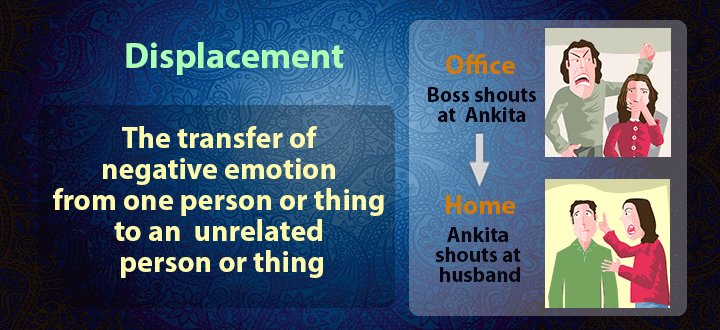Introduction
In this post, we will focus on understanding what is the psychological defense mechanism of displacement, why we use it, how it can lead to certain problems and the steps that a therapist can use to help the client who is facing issues due to displacement.
Defense Mechanism of Displacement: Case Study

A young girl recently called for therapy. When asked what it is for, she said, “My work is affecting my family life. I lose my temper at work because of my boss, he shouts and insults me like a moron, and I remove all the anger on my younger sister at home, and now, it is affecting my relationship with her. Please help!”
Haven’t we heard similar stories or even experienced this?
Well, this is a classic example of the defense mechanism of Displacement.
What is Displacement in Psychology?
In Freudian psychology, displacement (German: “shift, move”) is an unconscious defense mechanism whereby the mind substitutes either a new aim or a new object for goals felt in their original form to be dangerous or unacceptable.
Displacement involves shifting your true feelings from the original, anxiety-provoking provoking thought to a target that is less harmful or non-threatening (based on individual perception).
What causes Displacement?
Displacement occurs when we shift our emotions and actions from the actual desired target to a substitute target:
- Based on individual perceptions and beliefs about the circumstances or
- Due to the lack of skills to handle the circumstances
Like in the above example, the girl gets extremely angry at her boss, but she can’t do much since she fears losing her job, so in effect, the anger is directed at her younger sister, who she perceives as a safer target.
What is the purpose of the defense mechanism of displacement?
The purpose of this unconscious defense mechanism is generally to release the pent up emotions by directing it elsewhere, thereby causing less harm or, many times, no harm at all to the person feeling those emotions.
Problem with over-dependence on Displacement
However, if we are unaware of this displaced anger, or even if we are aware and the behaviour is often repeated, it could cause serious complications and issues in the person’s life. In the above case, this had already started to happen, as her relationship with her sister was indeed getting adversely affected.
How does displacement in psychology work?
- In some cases, like the case mentioned above, Displacement may involve retaining the action and simply shifting the target of that action. So, the girl wanted to shout back at her boss but instead displaced the shouting at her sister.
- However, at times, this way of Displacement might not be feasible. So, in this case, the person may change the action along with the target. For instance, if I cannot shout at my boss, I would take a punching bag and keep punching it till I feel better. This way of Displacement is often quite satisfactory and workable mechanisms for releasing energy more safely.
- Even dreams can be interpreted as the displacement of stored tensions into other forms (dreams are often highly metaphoric), e.g. a mouse hitting a dragon with a hockey stick. Where the dragon is the boss and the mouse is you.
Like every defense mechanism, displacement is good in the short run. However, it can lead to major complications when this continues in the long run. It is for this reason very important to channelize it in a healthy manner and come up with alternative solutions.
If you or someone you know has been using the defense mechanism of displacement and is seeking help to improve your current life situation, call us on +91-8080-2084-73 or use the contact us form.
Therapists Niche: Working with Displacement

When a client has been using the defense mechanism of displacement, there are two basic possibilities:
- The client may be unaware that he/she is displacing emotions
- The client may be aware that he/she is displacing emotions
Recommended Steps and Techniques
- If the client is unaware that he/she is using the defense mechanism of displacement, the therapist can help the client become aware of the same either:
- With the help of a structured interview (checkout Meta Model) or
- With the help of the NLP technique of Perceptual Position or
- By helping the client become more mindful of their emotions and their responses
- Once the client becomes aware of the displacement taking place, the next step is to help the client understand the original source of the emotion. The original source would include the person, the situation and the thought/belief that is causing the emotion. The therapist can use open-ended questions (Meta-model again) in combination with the ABC model from CBT.
- Next, help the client restructure the thought or the underlying belief identified in the previous step. If-then statement, NLP SWISH, and belief change processes can be used for the same.
- Next, help the client brainstorm strategies and identify skills that can help him/her deal with the original source more effectively. SOFT SEA™ Coaching process and NLP Modelling are the techniques that can be used for the same.
- Next, help the client release the current emotion (that was being displaced) and replace it with a more appropriate/resourceful emotion. Hypnodrama (drama in a hypnotic state combined with anchoring) is probably the best process to use for this purpose.
- Last, do future pacing so that the client can mentally rehearse the application of the new strategy and skills in the new resourceful state. Make necessary modification in the strategy if required.
All the techniques mentioned in this post and a lot more is what you learn and practice during the Cognitive Hypnotic Psychotherapy™ Program. It is the first and the only course that seamlessly integrates different approaches to psychotherapy (cognitive, behavioural, psycho-dynamic and humanistic) with techniques from Hypnosis, NLP, Metaphor Therapy and Mindfulness.

